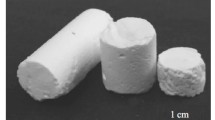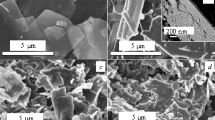Abstract
The possibility of reinforcing ceramic materials based on zirconium dioxide and phosphate binders is investigated. The effect of the molding pressure, solid/liquid ratio, method of manufacture, content and type of reinforcing material, and various modifications of the initial material on the bending strength is shown.
Similar content being viewed by others
References
S. L. Golynko-Vol’fson, M. M. Sychev, L. G. Sudakas, and L. I. Skoblo (eds.),Chemical Principles of the Technology and Application of Phosphate Binders and Coatings [in Russian], Khimiya, Leningrad (1968).
M. M. Sychev,Inorganic Adhesives [in Russian], Khimiya, Leningrad (1986).
V. A. Kopeikin, A. P. Petrova, and I. L. Rashkovan,Materials Based on Metal Phosphates [in Russian], Khimiya, Moscow (1976).
Carbon Fibers [Russian translation], Mir, Moscow (1987).
Physical Mesomechanics and Computer Design of Materials, Vol. 2 [in Russian], Nauka, Novosibirsk (1995).
Author information
Authors and Affiliations
Additional information
Translated from Steklo i Keramika, No. 3, pp. 16–18, March, 2000.
Rights and permissions
About this article
Cite this article
Guzeev, V.V., Tret’yakova, E.M. & Ivanova, L.R. Reinforced ceramic materials with phosphate binders. Glass Ceram 57, 91–93 (2000). https://doi.org/10.1007/BF02681516
Issue Date:
DOI: https://doi.org/10.1007/BF02681516




